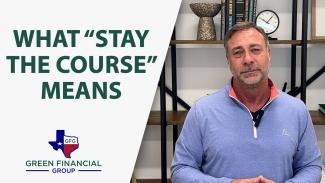
Understanding the Depth of ‘Stay the Course’
Explaining the true meaning behind the saying “stay the course.
At the end of my video blogs, I always say, “Stay the course,” but what do I truly mean by that, and how does it translate into real-life scenarios?
Recently, during a mundane drive down a congested highway, I had an enlightening experience that encapsulated the essence of this saying. Today, I’ll share this moment and delve into the deeper meaning behind this commonly used yet profoundly impactful adage.
While I was driving down the highway around 4 p.m., which was a terrible time due to heavy traffic, I found myself stuck behind an old pickup truck. We were crawling at two miles per hour. Feeling rushed, I attempted to switch lanes, thinking I was making progress by passing cars and in particular, get out from behind the slow old truck. I weaved and bobbed through traffic as space opened up and found my stress levels getting high because I wasn’t making much progress even though I was so focused on getting ahead. And of course, upon reaching my exit, I found myself behind that same old pickup truck – the same exact place I started.
“In essence, “stay the course” simply means staying focused.”
The lesson here is that all that weaving and maneuvering didn't actually get me anywhere. It just made me feel aggressive and a little stressed. So the expression 'Stay the course' alludes to this scenario—keeping steady usually gets you where you want to go. And as I mentioned in a recent podcast, 'slow and steady wins the race' in investing. If I had remained where I was, I may have reached my destination sooner or worst case scenario, I would have ended up in the same position as when I started.
So what I’m really saying here is that “stay the course” means staying focused on your goals. If you need help with your long-term investments, call or email me anytime. I’m always happy to help.
The information contained in this blog does not purport to be a complete description of the securities, markets, or developments referred to in this material. The information has been obtained from sources considered to be reliable, but we do not guarantee that the foregoing material is accurate or complete. Any opinions are those of the author, and not necessarily those of Raymond James. Expressions of opinion are as of this date and are subject to change without notice. There is no guarantee that these statements, opinions, or forecasts provided herein will prove to be correct.
Every investor's situation is unique and you should consider your investment goals, risk tolerance, and time horizon before making any investment. Investing involves risk and you may incur a profit or loss regardless of the strategy selected. The foregoing is not a recommendation to buy or sell any individual security or any combination of securities. Be sure to contact a qualified professional regarding your particular situation before making any investment or withdrawal decision.
